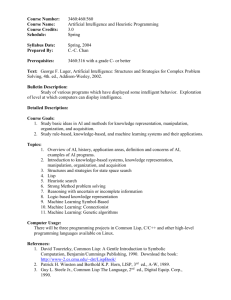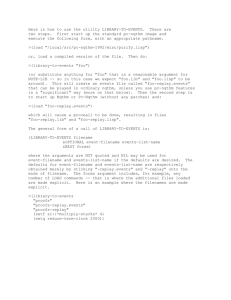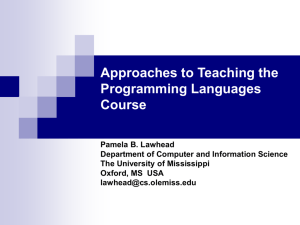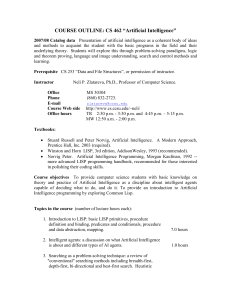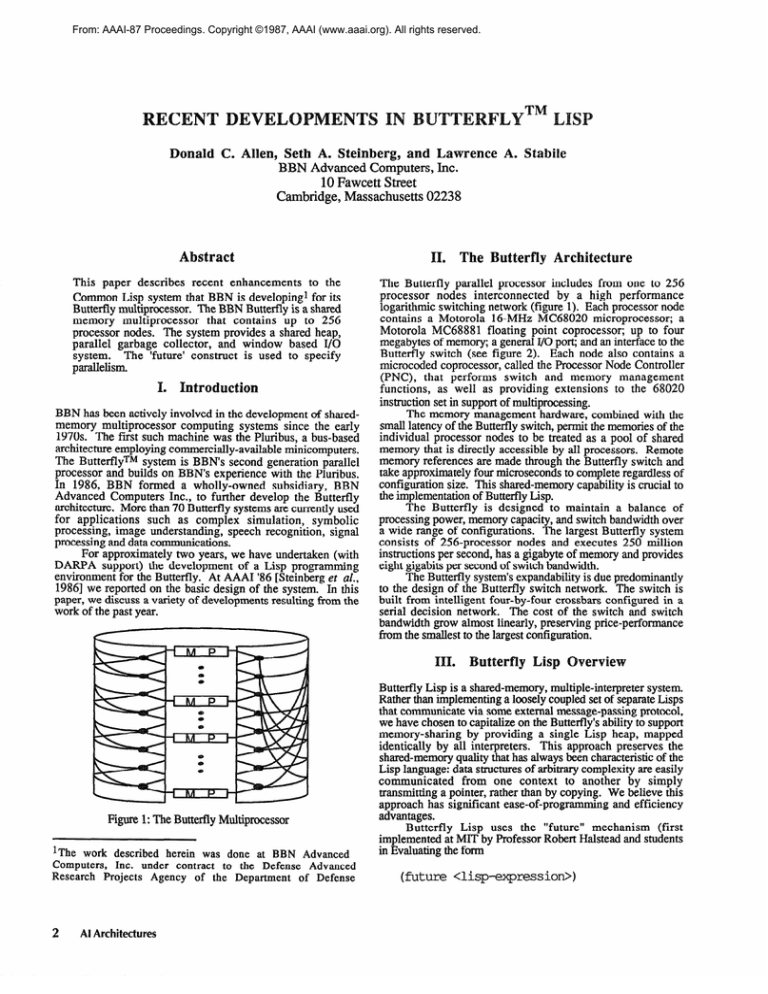
From: AAAI-87 Proceedings. Copyright ©1987, AAAI (www.aaai.org). All rights reserved.
Donald
@. Allen, Seth A. Steinberg, and Lawrence
BBN Advanced Computers, Inc.
10 Fawcett Street
Cambridge, Massachusetts 02238
Abstract
This paper describes recent enhancements to the
Common Lisp system that BBN is developing’ for its
Butterfly multiprocessor. The BBN Butterfly is a shared
memory multiprocessor
that contains up to 256
processor nodes. The system provides a shared heap,
parallel garbage collector, and window based I/Q
system.
The ‘future’ construct is used to specify
parallelism.
Introduction
BBN has been actively involved in the development of sharedmemory multiprocessor computing systems since the early
1970s. The first such machine was the Pluribus, a bus-based
architecture employing commercially-available minicomputers.
The ButterflyTM system is BBN’s second generation parallel
processor and builds on BBN’s experience with the Pluribus.
In 1986, BBN formed a wholly-owned subsidiary, BBN
Advanced Computers Inc., to further develop the Butterfly
architecture. More than 70 Butterfly systems are currently used
for applications
such as complex simulation,. symbolic
processing, image understanding, speech recognmon, signal
processing and data communications.
For approximately two years, we have undertaken (with
DARPA support) the development of a Lisp programming
environment for the Butterfly. At AAAI ‘86 [Steinberg et al.,
19861 we reported on the basic design of the system. In this
paper, we discuss a variety of developments resulting from the
work of the past year.
II.
IThe work described herein was done at BBN Advanced
Computers, Inc. under contract to the Defense Advanced
Research Projects Agency of the Department of Defense
2
Al Architectures
The Butterfly
Architecture
The Butterfly parallel processor includes from one to 256
processor nodes interconnected
by a high performance
logarithmic switching network (figure 1). Each processor node
contains a Motorola 16-M& MC68020 microprocessor; a
Motorola MC68881 floating point coprocessor; up to four
megabytes of memory; a general I/O port; and an interface to the
Butterfly switch (see figure 2). Each node also contains a
microcoded coprocessor, called the Processor Node Controller
(PNC), that performs switch and memory management
functions, as well as providing extensions to the 68020
instrnction set in support of multiprocessing.
The memory management hardware, combined with the
small latency of the Butterfly switch, permit the memories of the
individual processor nodes to be treated as a pool of shared
memory that is directly accessible by all processors. Remote
memory references are made through the Butterfly switch and
take approximately four microseconds to complete regardless of
configuration size. This shared-memory capability is crucial to
the implementation of Butterfly Lisp.
The Butterfly is designed to maintain a balance of
processing power, memory capacity, and switch bandwidth over
a wide range of configurations. The largest Butterfly system
consists of 256-processor nodes and executes 250 million
instructions per second, has a gigabyte of memory and provides
eight gigabits per second of switch bandwidth.
The Butterfly system’s expandability is due predominantly
to the design of the Butterfly switch network. The switch is
built from intelligent four-by-four crossbars configured in a
serial decision network. The cost of the switch and switch
bandwidth grow almost linearly, preserving price-performance
from the smallest to the largest con@uration.
III.
Figure 1: The Butterfly Multiprocessor
A. Stabile
utter
isp
verview
Butterfly Lisp is a shared-memory, multiple-interpreter system.
Rather than implementing a loosely coupled set of separate Lisps
that communicate via some external message-passing protocol,
we have chosen to capitalize on the Butterfly’s ability to support
memory-sharing by providing a single Lisp heap, mapped
identically by all interpreters. This approach preserves the
shared-memory quality that has always been characteristic of the
Lisp language: data structures of arbitrary complexity are easily
communicated
from one context to another by simply
transmitting a pointer, rather than by copying. We believe this
approach has significant ease-of-programming and efficiency
advantages.
Butterfly Lisp uses the “future” mechanism (first
implemented at MIT by Professor Robert Malstead and students
in Evaluating the form
(future<lisp-expression>)
causes the system to record that a request has been made
for the evaluation of <lisp-expression> andto commit resources
to that evaluation when they -become available. Control returns
immediately to the caller, returning a new type of Lisp object
called an “undetermined future”. The “undetermined future”
object serves as a placeholder for the value that the evaluation of
<lisp-expression> will ultimately produce. An “undetermined
future” may be manipulated as if it were an ordinary Lisp object:
it may be stored as the value of a svmbol. consed into a list.
passed as an argument to a function, etc.. If, however, it&
subjected to an operation that requires the value of clispexpression> prior to its arrival, that operation will automatically
be suspended until the value becomes available. The “future”
mechanism
provides
an elegant
abstraction
for the
synchronization required between the producer and consumer of
a value. This preserves and encourages the applicative
programming style so integral to Lisp programming and so
important in a parallel machine, where carelessness with sideeffecting operations can result in (difficult to diagnose)
probabilistic bugs.
The Butterfly Lisp implementation is based on MIT
CScheme, modified to support the future construct and other
multiprocessing
primitives
(e.g., primitives for mutual
exclusion). The system also includes a parallel stop-and-copy
garbage collector. In addition to the Scheme dialect of Lisp,
Butterfly Lisp also provides Common Lisp language support,
implemented largely on top of Scheme. This implementation,
which we discuss in detail below, uses significant portions of
CMU’s Spice Lisp.
The Butterfly Lisp compiler will be based on LIAR (LIAR
Imitates Apply Recursively), a Scheme compiler recently
developed at MIT by members of the Scheme Team.
The Butterfly Lisp User Interface (which leads to the rather
unfortunate acronym BLUI) is implemented on a Symbolics
3600-series Lisp Machine and communicates with the Butterflv
using Internet protocols. This system provides a means f&
controlling and communicating with tasks running on the
Butterfly, as well as providing a continuously updated display of
the overall system status and performance. Special Butterfly
Lisp interaction windows, associated with tasks running on the
Butterfly, may be easily selected, moved, resized, or folded up
into task icons.
There is also a Butterfly Lisp mode provided for the
ZMACS editor, which connects the various evaluation
commands (e.g., evaluate region) to an evaluation service task
running in the Butterfly Lisp system.
Each task is created with the potential to create an
interaction window on the Lisp machine. The first time an
operation is performed on one of the standard input or output
streams a message is sent to the Lisp machine and the associated
window is created. Output is directed to this window and any
input typed while the window is selected may be read by the
task. This multiple window approach makes it possible to use
standard system utilities like the trace package and the debugger.
A pane at the top of the screen is used to display the
system state. The system state information is collected by a
Butterfly process that is separate from the Butterfly Lisp system,
but has shared-memory access to important interpreter data
structures. The major feature of this pane is a horizontal
rectangle broken vertically into slices. Each slice shows the state
of a particular processor. If the top half of the slice is black,
then the processor is running, if gray, it is garbage collecting,
and if white, it is idle. The bottom half of each slice is a bar
graph that shows how much of each processor’s portion of the
heap is in use. The status pane also shows, in graphical form,
the number of tasks awaiting execution. This display makes
such performance problems as task starvation easy to recognize.
A recently developed User Interface facility provides a
display of a combined spawning and data-dependency, graph,
which is created from metering data collected during the running
of a Lisp program on the Butterfly. This facility is described in
detail below.
IV.
A.
aging Executio
Programs
Introduction
Computer software execution is both invisible and complex and
thus it has always been a challenge to present an image of how
programs are executing. Many tools have been developed to
perform this function
in uniprocessor
programming
environments.
For example, debuggers present a picture of
processor state frozen in time, while profilers provide a
summary distribution of program execution time. Useful as
these may be, the added dimension of concurrency renders the
typical suite of such tools insufficient. This realization led us to
the development of the capability described in this section.
.
Metering
and Presentation
Facillities
The Butterfly Lisp User Interface uses a transaction-oriented
protocol that carries the various logical I/Q streams between the
Butterfly and the 3600. To support our new imaging facility,
the protocol was extended so that the tasting system could
transmit a packet for each major scheduling operation. When
metering is enabled, a packet is sent when a task
- is created,
- begins executing on a processor,
- requires the final value of another task which has not yet
been computed,
Figure 2: The Butterfly Processor Node
- finishes executing,
Allen, §teinberg, and Stabile
3
- terminates, enabling another task to resume execution.
Each packet contains the time, the unique identifiers of the
relevant tasks and the processor number.
These packets allow the User Interface to construct a
complete lifetime history of each task, reconstruct the task
creation tree, and partially reconstruct the data dependency
graph. For efficiency reasons, if the value of a future has been
determined before it is needed, the reference is not recorded. The
User Interface presents this information in a special window.
The top pane of the window contains the task histories in depthfirst order of their creation. The bottom pane contains a derived
chart of aggregate information about the tasks in the system. In
both panes, the horizontal axis is the time axis and the two charts
are presented in the same time scale.
The history of each task is displayed as a horizontal
rectangle ranging along the time axis from task creation time to
task termination time. When vertical spacing permits, the gray
level indicates the state of the task that may be running (black),
on the scheduler queue (gray) or idle (white). The uppermost
task history rectangle in figure 3 shows a task that is created and
placed on the scheduler queue (gray). It then runs (black),
creating subtasks (see arrows), until it needs the value computed
by another task (see arrow). At this point it goes idle (white).
When the subtask has determined that value, this task is
requeued (gray) and then runs (black) to completion.
An arrow drawn from one task history to another indicates
that either:
- a task has created another task, or I
- a task needs the result of another task, or
- a terminating task has restarted another task
As the number of task histories to be shown increases, the
history rectangles will be made smaller. If necessary, the blackgray-white shadings will not be shown. If still more data is
available it will not be drawn, but can be displayed by using the
mouse to scroll the window. The mouse can also be used to
zoom in on the task histories by selecting a rectangular region,
which will be expanded to fill the entire window. This zooming
can be done repeatedly, and the image can be returned to its
original scale by pressing the middle mouse button. As an
additional aid to deciphering the task structure, pointing the
mouse at a particular task history will “pop up” the text
description of the task being computed.
The more conventional graph in the lower pane displays
the number of tasks in a particular state plotted against time.
Ordinarily, this graph shows the total number of tasks in the
system. There is a menu of graphing options that allows the
user to select a plot of any combination of running, queued, or
idling tasks.
The images in this paper were produced using an
interpreted version of Butterfly Lisp running on a 16 processor
Butterfly (with one node used for network communications).
Figure 3 was produced by the execution of the following
recursive Fibonacci algorithm:
(define(bbnacin); Pronouncedbi-bin; acci
(if (< n 2)
n
(+ (future(bbnaci(-1+n)))
(future(bbnaci(- n 2))))))
C. Example: Bayer-Moore
--------~------
--
mi
I
II
I
Theorem
Prover
The Boyer-Moore theorem prover (a classic early AI
program and part of the Gabriel Lisp benchmark suite [Gabriel,
19851) works by transforming the list structure representing the
theorem into a canonical form using a series of rewrite rules
called lemmas.
The final form, which resembles a tree
stmctured truth table, is scanned by a simple tautology checker.
The algorithm starts rewriting at the top level of the theorem and
recursively applies the rewriter to its results. Parallelism is
introduced by creating a subtask for each subtree that might need
to be transformed.
Figure 4 shows the proof of modus-ponens:
(implies(and (impliesa b) a) b)
Figure 3: Execution image of BBNACI function
Since the arrows are always associated with task state
changes, the actual meaning of a particular arrow can easily be
derived from the context. When a task is created, the creating
task continues running so the history rectangle is black to the
right of the creation arrow. When a task needs the result of
another task it will go idle so the history rectangle will go from
black to white. When a task terminates, the history rectangle
ends, and any waiting tasks are restarted.
4
Al Architectures
The proof performs 13 transformations that appear as the
13 clusters in the execution image. Two levels of parallelism are
visible. At the finer level, various tasks attempt to apply rewrite
rules, usually unsuccessfully.
Many short lived tasks are
created, but parallelism is limited by the small size of the
associated list stmcture. This limited parallelism appears within
each cluster of tasks. At the coarser level, the various lemmas
are applied and their dependencies are preserved. The first set of
transformations must be performed serially because each
depends on the results of the previous one.
Later
transformations
can be performed in parallel on isolated
subbranches of the expanded list structure. This parallelism
appears in the arrangement of the clusters.
The rectangle drawn around cluster 6 is a region that has
been selected for enlargement. Clicking the left mouse button
changes the cursor from an arrow to the upper left hand comer
of a rectangle. When this is clicked into place, the mouse allows
the user to “rubber band” a rectangle by moving the lower right
hand corner. The next click enlarges the region within the
rectangle, filling the entire screen as shown in figure 5.
D. Summary
The illustrations in this paper demonstrate the utility of this
new parallel program execution imaging technique. In the future,
we will add a variety of viewing modes to provide alternate
images of execution and we plan to allow the user to explicitly
annotate the diagram by sending appropriate data packets. It
should also be possible to use the metering data to detect circular
dependencies, unused task subtrees, task starvation, and other
common pitfalls on the path to parallelism.
utterfly
Common
Lisp
A key aspect of the Butterfly Lisp effort is the support of a
concurrent variant of Common Lisp. In this section we discuss
some of the issues that arise in building a Common Lisp on a
Scheme base.
A. Scheme
Scheme is a dialect of Lisp developed at MIT by Gerald J.
Sussman and Guy Steele in 1975. While the language has
evolved during the past 12 years [Rees et aE.., 19861, it has,
from the beginning, featured lexical-scoping, tail-recursion, and
first-class procedural objects, which unify the operator and
operand name spaces (the first element of a form is evaluated in
exactly the same manner as the rest). Scheme is in an excellent
base on which to build a Common Lisp, having simple,
powerful and well-defined semantics. For example, Scheme
provides a very general facility for creating advanced control
structures,
i.e., the ability to create and manipulate
‘continuations’ (the future course of a computation) as first-class
objects. This capability is critical to, and greatly simplifies, our
implementations of Common Lisp tagbodies, block/return-from,
and catch/throw. In addition to the language features described
in the Scheme report [Rees et al.., 19861, Butterfly Common
Lisp makes significant use of extensions to the language
provided by MIT CScheme:
- Environments are first-class objects, i.e., environment
objects, and operations on them, are directly accessible to the
user.
- The Eva1 function exists, accepting an environment
required second argument.
as a
Figure 4: Execution image of Boyer-Moore Theorem Prover
capitalize as much as possible on CMU’s excellent Common
Lisp, Spice.
Our task then became one of identifying and implementing
enough of the basic Common Lisp semantics to be able employ
the CMU Common Lisp-in-Common Lisp code. Happily, in
many cases, Scheme and Common Lisp were identical or nearly
so. In others, language differences required resolution; Common
Lisp’s separate operator/operand name spaces are an example.
Here, an obvious solution would have been to add a function
definition cell to the symbol data structures, necessitating a nontrivial interpreter and compiler modification in the treatment of
the evaluation of the frst element of function-application forms.
We chose a less invasive solution: when the Scheme syntaxer
(which converts reader-produced list structure into S-code, the
input to both the interpreter and the compiler) senses any form
with a symbol in the function position, it substitutes a new,
unintemed symbol having a pname that is derived from the
pname of the original. Function-defining
constructs, e.g.,
defun, (setf (symbol-function)), place the functional objects in
the value cell of the corresponding mutated symbol. The symbol
block has been expanded so that the pairs can point to each
other.
- CScheme provides many of the arithmetic types required by
Common
Lisp,
including
an efficient
bignum
implementation.
- Lambda lists that support rest and optional arguments:
sufficient power on which to construct Common Lisp’s
more complex lambda lists.
- A macro facility of sufficient power to construct Defmacro.
- A simple protocol for adding new primitives, written in C, to
support some of the more esoteric Common Lisp operations.
- Fluid-let, a dynamic-binding construct that is used in the
implementation of Common Lisp special variables
- Dynamic-wind,
protect
B. Mapping
a generalization of Common Lisp unwind-
from Common
I
11
Lisp to Scheme
It was decided early in the evolution of our Common Lisp that
we would avoid modifications to the Scheme interpreter and
compiler, unless semantic or performance considerations
dictated otherwise. In addition, we decided that we would
Figure 5: Execution image of Boyer-Moore
Theorem Prover -- close-up view
Allen, Steinberg, and Stabile
5
Common Lisp packages are another example of the gulf
between the two languages; Scheme relies exclusively on lexical
scoping to solve name-conflict problems. ‘The solution was
simply a matter of extending the symbol table system of Scheme
to accommodate the needs of the Spice Lisp package system and
reader. This has amounted to little more that porting the Spice
Lisp package system, and viewing Scheme symbols as
belonging to Be ‘Lisp’ package. To do this, the package
operations are multiplexed between the Scheme and Spice data
structures via a simple object-oriented tool.
Common Lisp provides a large set of control mechanisms,
including looping and branching. Scheme has no inherent
looping or branching, and instead relies on tail-recursion
optimization for efficient iteration and on continuations for other
types of control structures.
The simpler looping forms of Common Lisp are easy to
implement in Scheme. For example, examine the following
simple use of dotimes, in which no go’s appear:
(dotimes(i n) (print(factorial
i)))
transforms to the Scheme:
(let
0
(define(dotimes-loop-1234
i)
(if (= i n)
nil
(begin
(print(factorial
i))
(dotimes-loop-1234
(l+i)))))
(dcjtims-loop-1234
0))
The more complicated branching implied by tagbody is
implemented using continuations. In essence, the sections of a
tagbody between labels become zero-argument procedures that
are applied in sequence, calling each other tail-recursively to
perform a go.
Mechanisms for paraIlelism extant in Butterfly Lisp are
inherited by Common Lisp. These include future, the locking
primitives, and all metering and user-interface facilities, such as
the imaging system described in section 4.
Currently, almost all of Common Lisp is implemented and
runs in interpreted mode. Much of Portable Common Loops, a
severe test of any Common Lisp implementation, has been
ported.
I&p Compiler
The Butterfly Lisp compiler will be based on a new Scheme
compiler, LIAR, recently developed at MIT. LIAR performs
extensive analysis of the source program in order to produce
highly optimized code. In particular, it does a careful
examination of program structure in order to distinguish
functions whose environment frames have dynamic extent, and
are thus stack-allocatable, from those requiring frames of
indefinite extent, whose storage must be allocated from the Lisp
heap. This is an extremely important efficiency measure,
dramatically reducing garbage collection time.
LIAR also deals efficiently with an interaction between
lexical scoping and tail-recursion: a procedure called tail
recursively may make a free reference to a binding in the caller’s
frame, thus it is not always possible for the caller to pop his own
frame prior to a tail-recursive call; the callee must do it.
6
Al Architectures
Acknwdedgements
The authors would like to thank the following people for their
contributions to our efforts:
- The MIT Scheme Team: Jim Miller, Chris IIanson, Bill
Rozas, and Professor Gerald J. Sussman, for their
tremendous skill, cooperation, and support.
- Laura Bagnall, the person responsible for all the magic that
happens on the 3600 side of our system. Laura was a
member of our team almost since the project’s inception and
recently left us to return to MIT in pursuit of a Ph. D.
- Jonathan Payne, a University of Rochester undergraduate
who has worked with us during school vacations, and has
made a very significant contribution to the project,
particularly to the Common Lisp implementation.
- DARPA, for providing support for this work.
c. Implementation Status
VI. The Butterfly
Furthermore, the compiler cannot always know how the called
procedure will be called (tail-recursively or otherwise), and thus
cannot statically emit code to clean up the stack, since the
requirements are different in the two cases. This is a problem
that requires a runtime decision about how to deal with the stack.
LIAR handles this with an extremely efficient technique that
preserves the semantics of lexical scoping and the constant-space
attribute of tail-recursion.
At the time of this writing, LIAR is undergoing extensive
testing both at MIT (on the HP Bobcat) and at BBN on the Sun
3. The port to the Butterfly computer will begin shortly and is
expected to take a matter of weeks. In addition, the compiler will
continue to be refined (certain basic optimizations, such as user
control over in-lining of primitives -- the compiler presently inlines only car, cdr, and cons -- have been omitted for the
present, the strategy being to get a relatively unadorned version
working first). We will also be modifying the compiler in behalf
of Common Lisp. In particular, processing of Common Lisp’s
optional type, ‘inline’, and ‘optimize’declarations can be critical
in achieving acceptable Common Lisp performance on a
processor such as the MC68020.
It is hoped that we will be able to report results obtained
from running compiled Lisp on the Butterfly at the time of the
conference.
References
[Steinberg et al., 19861 Steinberg, S., Allen, D., Bagnall, L.,
Scott, C. The Butterfly Lisp System Proceedings of the August
1986 AAAI, Volume 2, Philadelphia, PA, pp. 730
[Crowther et al.., 19851 Crowther, W., Goodhue, J., Starr, E.,
Milliken, W., Blackadar, T. Performance Measurements on a
12%Node Butterfly Parallel Processor Internal Bolt, Beranek
and Newman Paper, Cambridge, Massachusetts
[Gabriel, 19851 Gabriel, R. Performance and Evaluation of Lisp
Systems MIT Press, 1985
[Halstead, 19851 Halstead, R. Multilisp: A Language for
Concurrent Symbolic Computation
ACM Transactions on
Programruing Languages and Systems
[Rees et al.., 19861 Rees, J., Clinger, W., et al Revised3 Report
on the Algorithmic Language Scheme MIT report, Cambridge,
Mass.

